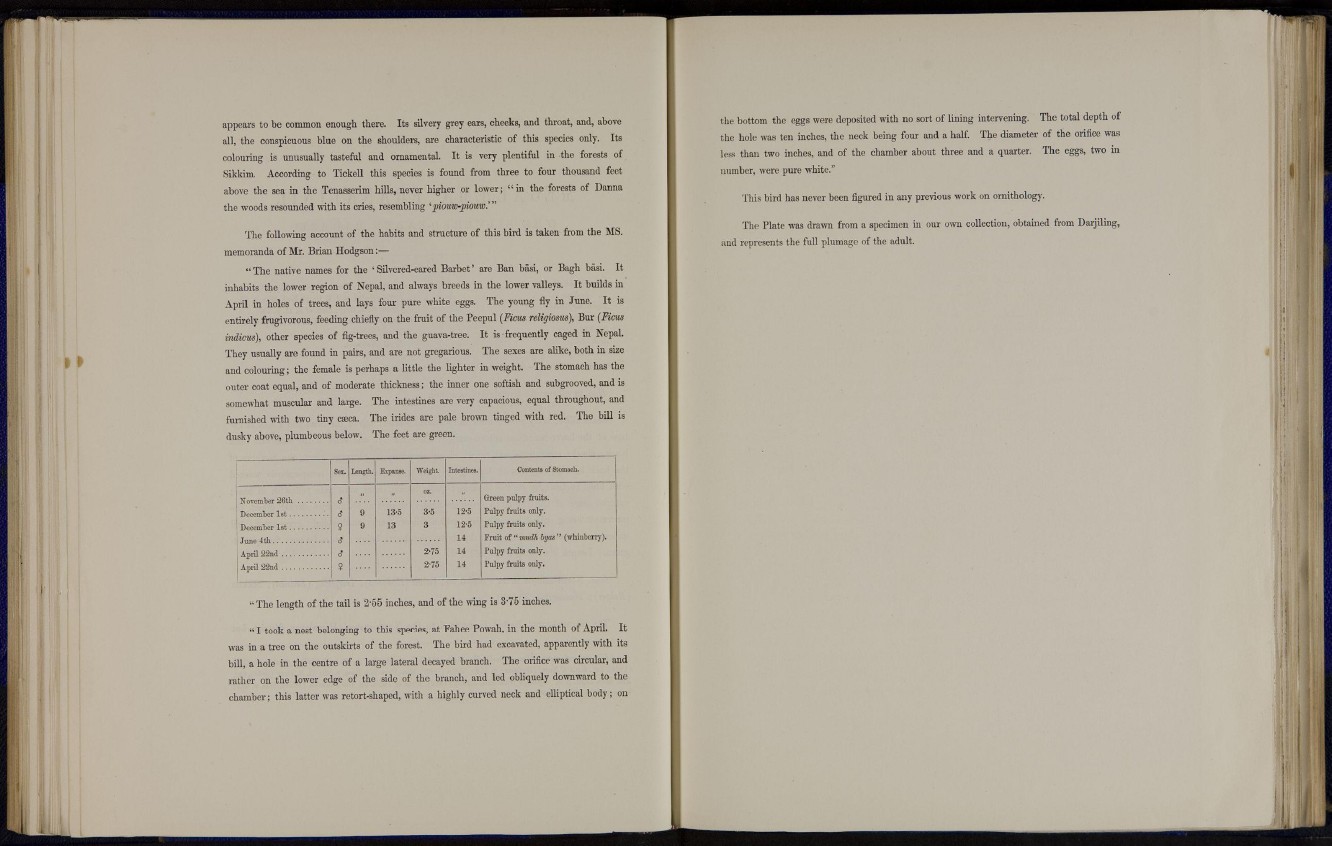
appears to be common enough there. Its silvery grey ears, cheeks, and throat, and, above
all, the conspicuous blue on the shoulders, are characteristic of this species only. Its
colouring is unusually tasteful and ornamental. It is very plentiful in the forests of
Sikkim. According to Tickell this species is found from three to four thousand feet
above the sea in t h e Tenasserim hills, never higher or lower; " i n the forests of Danna
the woods resounded with its cries, resembling ' piouw-piouw.'"
The following account of the habits and structure of this bird is taken from the MS.
memoranda of Mr. Brian Hodgson:—
" The native names for the ' Silvered-eared Barbet' are Ban basi, or Bagh basi. It
inhabits the lower region of Nepal, and always breeds in the lower valleys. It builds in
April in holes of trees, and lays four pure white eggs. The young fly in June. It is
entirely frugivorous, feeding chiefly on t h e fruit of t h e Peepul (Ficus religiosus), Bur (Ficus
indicus), other species of fig-trees, and the guava-tree. It is frequently caged in Nepal.
They usually are found in pairs, and are not gregarious. The sexes are alike, both in size
and colouring; the female is perhaps a little the lighter in weight. The stomach has t he
outer coat equal, and of moderate thickness; the inner one softish and subgrooved, and is
somewhat muscular and large. The intestines are very capacious, equal throughout, and
furnished with two tiny caeca. The irides are pale brown tinged with red. The bill is
dusky above, plumbeous below. The feet are green.
November 26th
December 1st.
December 1st .
June 4 th
April 22nd . ..
April 22nd . ..
Length.
13-5
13
Weight.
2-75
2-75
12-5
12-5
14
14
14
Contents of Stomach.
Green pulpy fruits.
Pulpy fruits only.
Pulpy fruits only.
Fruit of " mudh bya
Pulpy fruits only.
Pulpy fruits only.
(whinberry).
" The length of the tail is 2-55 inches, and of the wing is 3-75 inches.
" I took a nest belonging to this species, at Fahee Powah, in the month of April. It
was in a tree on the outskirts of the forest. The bird had excavated, apparently with its
bill, a hole in the centre of a large lateral decayed branch. The orifice was circular, and
rather on the lower edge of the side of the branch, and led obliquely downward to the
chamber; this latter was retort-shaped, with a highly curved neck and elliptical body; on
the bottom the eggs were deposited with no sort of lining intervening. The total depth of
t h e hole was ten inches, the neck being four and a half. The diameter of the orifice was
less than two inches, and of the chamber about three and a quarter. The eggs, two in
number, were pure white."
This bird has never been figured in any previous work on ornithology.
The Plate was drawn from a specimen in our own collection, obtained from Darjiling,
and represents the full plumage of the adult.